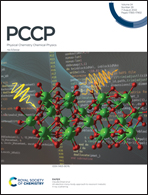Biaxial stress and functional groups (T = O, F, and Cl) tuning the structural, mechanical, and electronic properties of monolayer molybdenum carbide
Abstract
MXenes are a family of novel two-dimensional (2D) materials attracting intensive interest because of the rich chemistry rooted from the highly diversified surface functional groups. This enables the chemical optimization suitable for versatile applications, including energy conversion and storage, sensors, and catalysis. This work reports the ab initio study of the crystal energetics, electronic properties, and mechanical properties, and the impacts of strain on the electronic properties of tetragonal (1T) and hexagonal (2H) phases of Mo2C as well as the surface-terminated Mo2CT2 (T = O, F, and Cl). Our findings indicate that 2H-Mo2C is energetically more stabilized than the 1T counterpart, and the 1T-to-2H transition requires a substantial energy of 210 meV per atom. The presence of surface termination T atoms on Mo2C intrinsically induces variations in the atomic structure. The calculated structures were selected based on the energetic and thermodynamic stabilities (400 K). The O atom prefers to be terminated on 2H-Mo2C, whereas the Cl atom energetically stabilizes on 1T-Mo2C. Meanwhile, with certain configurations, 2H-Mo2CF2 and 1T-Mo2CF2 with slightly different energies could exist simultaneously. The Mo2CO2 possesses the highest mechanical strength and elastic modulus (σmax = 52 GPa at εb = 20% and E = 507 GPa). The nature of the ordered centrosymmetric layer and the strong bonding between 4 d-Mo and 2 p-O of 2H-Mo2CO2 are responsible for its promising mechanical properties. Interestingly, the topological properties of 2H-Mo2CO2 at a wide range of strains (−10% to 12%) are reported. Moreover, 2H-Mo2CF2 is metallic through the range of calculation. Meanwhile, originally semiconducting 1T-Mo2CF2 and 1T-Mo2CCl2 preserve their features under the ranges of the strain of −2% to 10% and −1% to 5%, respectively, beyond which they undergo the semiconductor-to-metal transitions. These findings would guide the potential applications in modern 2D straintronic devices.



 Please wait while we load your content...
Please wait while we load your content...